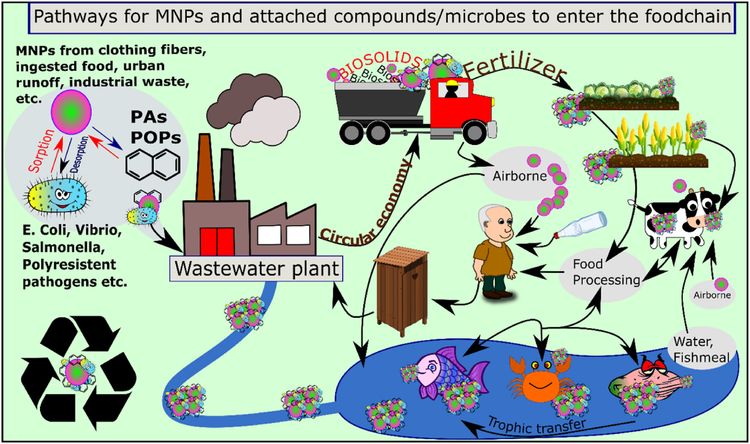Study: Plastic Prevalent In Food

Summary: MNP movement in the environment can affect global food safety and security. The diagram shows the main pathways, but it's not comprehensive. Source: TrAC Trends in Analytical Chemistry (2023), DOI: 10.1016/j.trac.2023.116993.
A recent study by CSIRO has discovered that micro and nanoplastics are abundant in our food supply. This might be a global issue that could impact food safety and security.
This research is among the initial ones that investigate micoroplastic literature in relation to food safety and security. Earlier studies focused more on plastic in fish.
Plastics and additives can be found in several things like fish, meat, chicken, rice, water, take-away food and drinks, and even fresh fruits. They're present in different amounts.
Dr. Jordi Nelis led a team of researchers who discovered plastics in the human food chain. The plastics can enter the food chain in several ways, like being eaten by fish, or through packaging and processing food. The research is published in TrAC Trends in Analytical Chemistry. Dr. Nelis is an analytical chemist and food safety expert at CSIRO.
According to Dr. Nelis, fresh food can start without plastic. But during handling and packaging, it might get plastic. This affects us when we consume it.
Food can have micro and nanoplastics from machinery, cutting boards, and plastic wrapping. We must know which plastics can end up in our food for safety. A study shows this need for understanding.
Contaminants can enter agriculture through biosolids. Biosolids come from wastewater treatment.
Biosolids help crops grow, but they have plastic bits. The plastic may come from washing synthetic clothes.
Particles can accumulate in the soil and alter its structure. This can impact crop production, food security, and ecosystem strength. For example, plastics can deceive good bacteria by pretending to be roots. As a consequence, plants get fewer nutrients.
The research talked about chemicals in plastics that let them work well, but may also go into the environment and cause food pollution. Some of these chemicals make plastic bend or stop UV rays and may include harmful substances like flame retardants or metals.
We don't have proof that micro and nanoplastics harm humans. But, we need more research. That way, we can understand the effects on our health.
We need more research about the effects of plastics on food safety and security. Also, we need better techniques to monitor safe levels in food, water, and farming systems. Additionally, we need to study the impact of plastic additives on food safety and security.
Dr. Nelis said we don't know safe levels of microplastics. It's missing information. We don't know the microplastic flux through food or safe levels yet.
He suggested ways for consumers to lower micro and nanoplastic levels in the environment.
Australians throw away 100 kg of plastic waste per year. Dr. Nelis recommends using less plastic in the kitchen and washing clothes less frequently on shorter cycles.
CSIRO's goal is to reduce plastic waste by 80% in Australia by 2030. They want to end plastic waste.
You can find out more about food safety and security risks related to micro- and nanoplastic pollution in a new study. The study is called "The measurement of food safety and security risks associated with micro- and nanoplastic pollution" and was conducted by Joost L.D. Nelis and his team. The study was published in TrAC Trends in Analytical Chemistry in 2023. You can access the study by clicking on the DOI link provided in the article.
A new study says plastic is everywhere in our food. You can find it in fish, meat, and salt. Even bottled water has plastic in it. The study says people could be eating too much plastic. This could be bad for our health. The study looked at plastic in food from around the world. Experts say we need to do more to stop plastic pollution. This could help keep our food and our bodies healthy.
You can't copy this document without permission. It's protected by copyright. You can only use it for private study or research. It's not for any other purpose. The information is only for your knowledge.









































